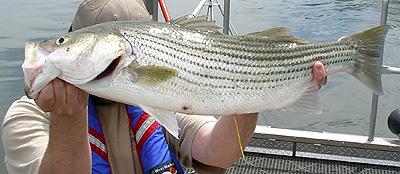
The S.C. Department of Natural Resources recently completed the stocking of over 4.2 million hatchery raised striped bass fingerlings throughout the state, with over 2.5 million stocked in the Santee Cooper system between Lakes Marion and Moultrie.
The stocking by the S.C. Department of Natural Resources (DNR) is intended to supplement natural reproduction that has historically maintained the Santee Cooper striped bass population and maintain otherwise unsustainable stocks in other state lakes. In addition to the stocking in the Santee Cooper system, striped bass were stocked in Lake Greenwood, Lake Hartwell, Lake Murray, Lake Thurmond, and Lake Wateree. None of these lakes currently have natural spawning populations.
Striped bass fry for all DNR stockings were produced at the DNR’s Jack Bayless Fish Hatchery in St. Stephens. Prior to being stocked in the lakes fry were grown out at one of DNR’s four warm water hatcheries or in Orangeburg at the US Fish and Wildlife Federal Hatchery to one to two-inch fingerlings.
Funding for the Jack Bayless Fish Hatchery and the striped bass stockings comes from license fees and Sport Fish Restoration Funds, which are derived from a federal excise tax on selected fishing gear and motorboat fuel.
This spring stocking season also saw stocking of 762,036 striped bass white bass hybrid in Lake Hartwell and Lake Thurmond and 24,000 American shad in the Broad River allowing DNR to meet stocking goals outlined in stocking plans for our state’s various waterways.
The DNR Freshwater Fisheries Section annually stocks from seven to 10 million fish in state waters, including striped and hybrid bass, largemouth and smallmouth bass, channel and blue catfish, bluegill, redbreast, redear sunfish (shellcracker), and rainbow, brook, and brown trout.
Anglers in South Carolina spend over $1 billion to fish each year according to 2006 reports, making the sport, with economic multipliers factored in a premier business in the Palmetto State.




Be the first to comment